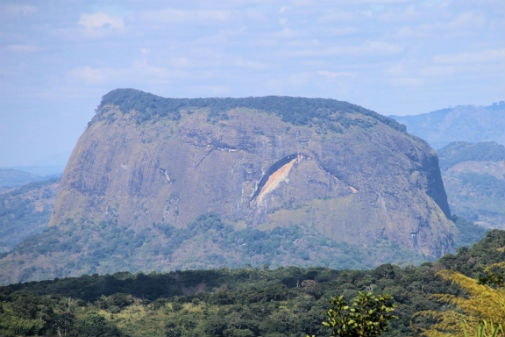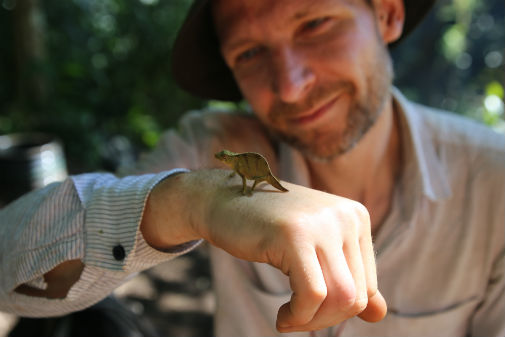York academic part of ‘dream team’ of scientists who explored remote African forest
Posted on 21 June 2018

Mount Lico rises 700 metres from the ground. Pic credit: Dr Platts
Dr Phil Platts was part of a multi-national team of biologists, climatologists, plant experts and climbers to tackle the remote Mount Lico in Mozambique.
However, this was no ordinary field trip.
Climbers
The 28-strong team faced a formidable physical challenge as Mount Lico rises vertically 700 metres from the ground with the forest nestled in its crater at the summit.
Undeterred, the team employed the services of professional climbers to scale a shorter cliff of about 125 metres on one side to access the forest, approached via a steep ascent through thick vegetation.
The climbers secured ropes from a sturdy tree at the forest edge all the way down to the bottom of the cliff, which the scientists then used get up and down safely.
The blood, sweat and countless ant attacks paid off, with the scientists already confirming a new species of butterfly, which they hope to name after the mountain.
In the months to come further tests are expected to confirm a line-up of potential new species, including snakes, frogs, toads, a snake-like amphibian, a shrew, a snub-nosed rodent, more butterflies, crabs and possibly a flowering plant.
Dr Platts, a conservation scientist in the University’s Environment Department, was involved in surveying the structure of the forest and its canopy, as well as digging pits to sample the soils as they would have accumulated through time.
Climate change
Back in the lab the samples will be analysed for pollen and charcoal deposits, to reconstruct how this ancient ecosystem has responded to past climatic cycles.
His findings and analysis will be published in the coming years and will further our understanding of how forests respond to climate change.
He said: “Mount Lico is a rare window into a world without humans – a unique opportunity to understand how forests behave in the absence of people.
“All the other forests we know of are open to human disturbance, or have been in the past. But the forest on Lico is different, protected by a near-vertical wall all the way around – it is pristine, a very special place.”

Dr Platts examines a dwarf chameleon which was found on the expedition. Pic credit: Dr Platts
The site was first revealed as new to science by Prof Julian Bayliss from Oxford Brookes University, who spent two years assembling his team and planning the expedition. The mountain itself was known only to locals and, until now, the forest on top remained a mystery.
The project was funded in part by Ranulph Fiennes’s Transglobe Expedition Trust, UK-based Biocensus, as well as the African Butterfly Research Institute.
Further information:
https://www.theguardian.com/world/2018/jun/17/mozambique-mount-lico-rainforest-new-species
Explore more news

Sodium channels in breast cancer cells a promising target for future treatments, study reveals
Thursday 25 July 2024

Cooling the classroom: University of York researchers to investigate UK schools’ responses to hot weather
Wednesday 24 July 2024

Hunter-gatherers kept an 'orderly home' in the earliest known British dwelling, study shows
Tuesday 23 July 2024

Study uses Game of Thrones to advance understanding of face blindness
Tuesday 23 July 2024

York academic contributes to new report on men’s health which reveals disparities between most and least deprived areas in the UK
Wednesday 17 July 2024
Media enquiries
About this research
Dr Phil Platts is a researcher in the University of York's Environment Department. He was part of the Mount Lico expedition to Mozambique which was an academic partnership between 13 universities, museums and research institutions on three continents, including the Natural History Museum and National Herbarium in Mozambique. Explore our research.
